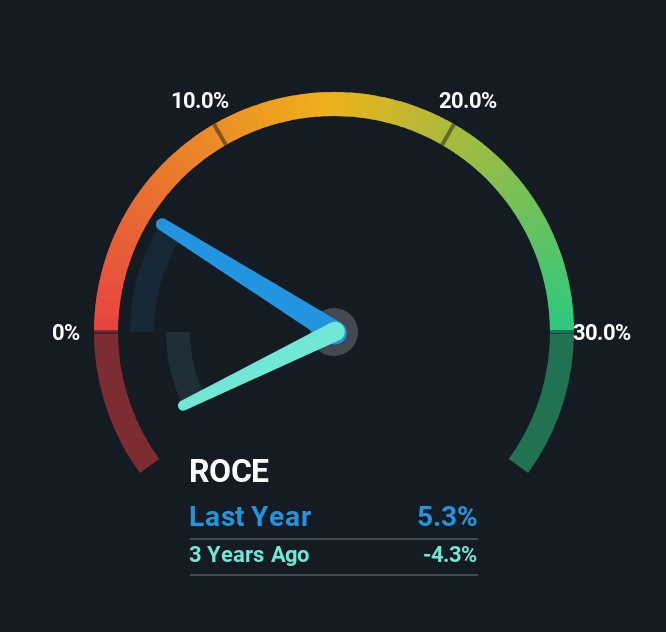Investors Will Want Deutsche Lufthansa's (ETR:LHA) Growth In ROCE To Persist
What are the early trends we should look for to identify a stock that could multiply in value over the long term? Firstly, we'll want to see a proven return on capital employed (ROCE) that is increasing, and secondly, an expanding base of capital employed. If you see this, it typically means it's a company with a great business model and plenty of profitable reinvestment opportunities. With that in mind, we've noticed some promising trends at Deutsche Lufthansa (ETR:LHA) so let's look a bit deeper.
Return On Capital Employed (ROCE): What Is It?
Just to clarify if you're unsure, ROCE is a metric for evaluating how much pre-tax income (in percentage terms) a company earns on the capital invested in its business. To calculate this metric for Deutsche Lufthansa, this is the formula:
Return on Capital Employed = Earnings Before Interest and Tax (EBIT) ÷ (Total Assets - Current Liabilities)
0.053 = €1.4b ÷ (€48b - €21b) (Based on the trailing twelve months to March 2025).
Therefore, Deutsche Lufthansa has an ROCE of 5.3%. Ultimately, that's a low return and it under-performs the Airlines industry average of 9.2%.
Check out our latest analysis for Deutsche Lufthansa

Above you can see how the current ROCE for Deutsche Lufthansa compares to its prior returns on capital, but there's only so much you can tell from the past. If you're interested, you can view the analysts predictions in our free analyst report for Deutsche Lufthansa .
The Trend Of ROCE
Deutsche Lufthansa's ROCE growth is quite impressive. The figures show that over the last five years, ROCE has grown 116% whilst employing roughly the same amount of capital. Basically the business is generating higher returns from the same amount of capital and that is proof that there are improvements in the company's efficiencies. The company is doing well in that sense, and it's worth investigating what the management team has planned for long term growth prospects.
On a side note, Deutsche Lufthansa's current liabilities are still rather high at 44% of total assets. This can bring about some risks because the company is basically operating with a rather large reliance on its suppliers or other sorts of short-term creditors. While it's not necessarily a bad thing, it can be beneficial if this ratio is lower.
The Bottom Line On Deutsche Lufthansa's ROCE
To sum it up, Deutsche Lufthansa is collecting higher returns from the same amount of capital, and that's impressive. Since the stock has only returned 28% to shareholders over the last five years, the promising fundamentals may not be recognized yet by investors. So with that in mind, we think the stock deserves further research.
Deutsche Lufthansa does have some risks though, and we've spotted 2 warning signs for Deutsche Lufthansa that you might be interested in.
For those who like to invest in solid companies, check out this free list of companies with solid balance sheets and high returns on equity.
Have feedback on this article? Concerned about the content? Get in touch with us directly. Alternatively, email editorial-team (at) simplywallst.com.
This article by Simply Wall St is general in nature. We provide commentary based on historical data and analyst forecasts only using an unbiased methodology and our articles are not intended to be financial advice. It does not constitute a recommendation to buy or sell any stock, and does not take account of your objectives, or your financial situation. We aim to bring you long-term focused analysis driven by fundamental data. Note that our analysis may not factor in the latest price-sensitive company announcements or qualitative material. Simply Wall St has no position in any stocks mentioned.
 Wall Street Journal
Wall Street Journal